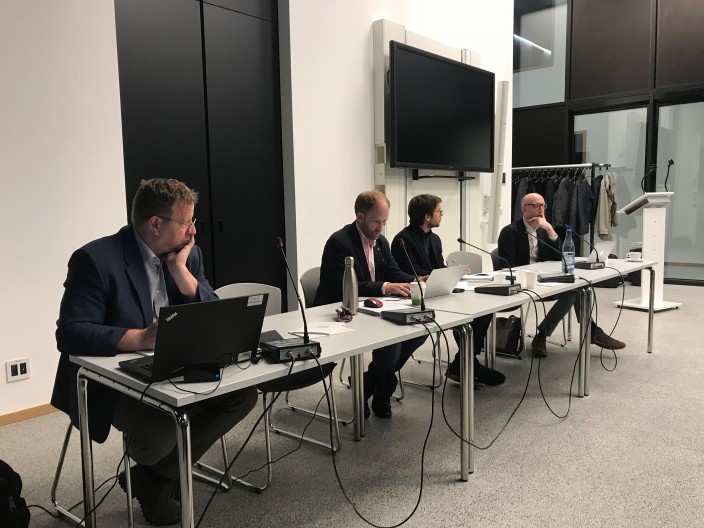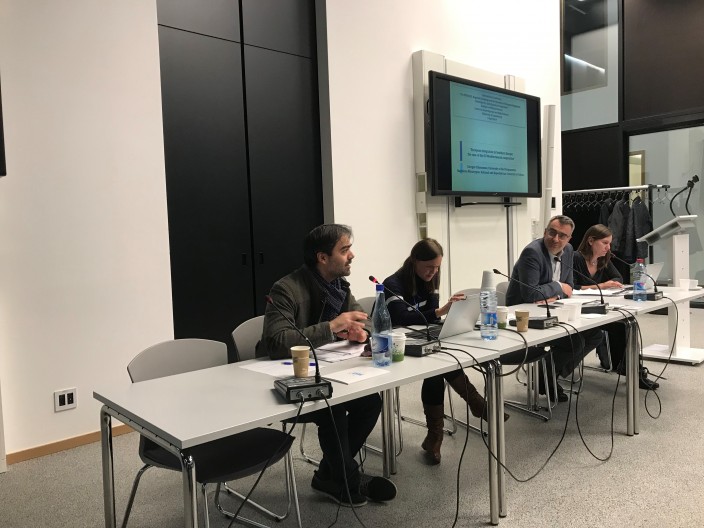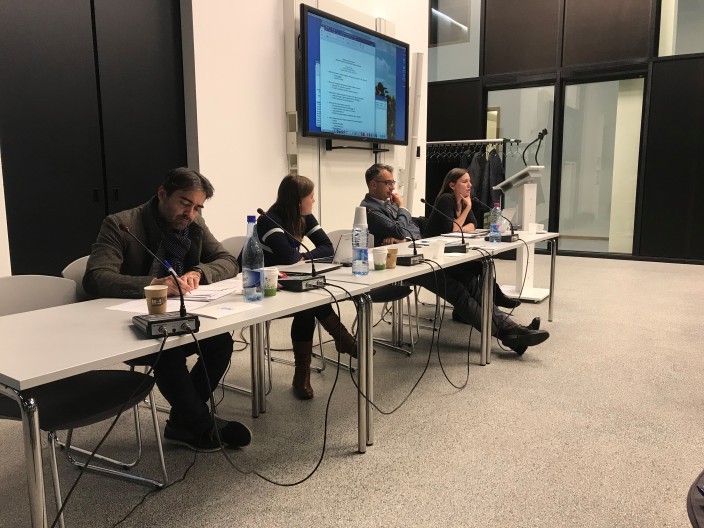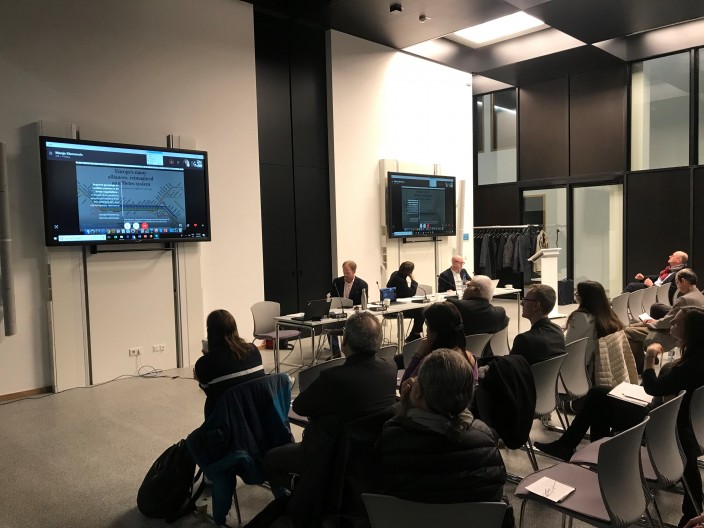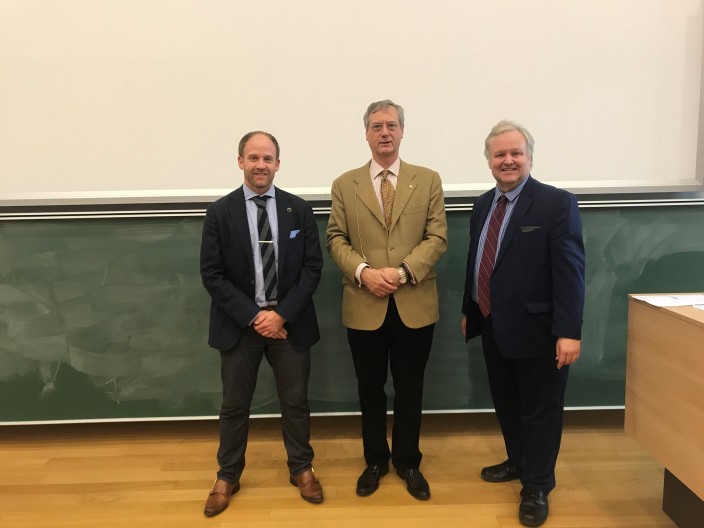The BENELUX and the Nordic Council both offer longstanding models of regional cooperation, which have, in various ways, often been cited as examples for the wider European integration project. More recently, both the Visegrád and Baltic states have seen the (re-) emergence of forms of regional cooperation in connection with their accession to and later membership of the European Union. Yet, though often cited, these experiences of (sub-)regional cooperation within the wider European project have been the object of relatively little systematic or comparative study. The present conference addressed this gap by bringing together specialists on these regional groupings with a view to providing a fuller understanding of both their historical significance and their possible future role relative to a potentially fragmenting European political landscape.
The conference comprised both a keynote event on the evening of Monday 8 April and a one-day workshop on Tuesday 9 April, with conference sessions dealing with both the historical and contemporary dimensions of such regional groupings. The panels (explained in greater detail below) dealt both with the specific experiences of the BENELUX and with the experiences of other comparable groupings such as (but not limited to) the Nordic Council, the Baltic states and the Visegrád group. The papers that were presented dealt with such topics as: the manner in which such groups have allowed for the development of specific forms of (deeper/different) cooperation amongst their member countries; the use of such groups as a means to coordinate policy with a view to enhancing the collective influence of their members within wider fora; the role of such (sub-)groupings as potentially both accelerators and brakes in relation to wider processes of European integration; and the place assumed by such groupings within overall national foreign policies.
Keynote by Benelux Secretary General Thomas Antoine
On Monday evening, the conference began with a keynote address by Benelux Secretary General Thomas Antoine. Mr. Antoine explained the raison d’être of the BENELUX, and articulated the ways in which the three members worked together on such initiatives as diploma recognition and the sharing of information between police agencies. Mr. Antoine then explained what he believed to be the core mission of diplomats, and how the BENELUX, both in terms of the individual members, and the organization itself, was continuing to fulfill its historical mission as a laboratory of sorts, demonstrating how to achieve greater levels of cooperation. His speech was followed by a buffet dînatoire in the MSA, which gave the attendees and speakers a chance to meet and mingle before the seminar the next day.
Roundtable discussion
The workshop reconvened the next morning with a roundtable discussion on the Benelux. The session brought together specialists from each of the three member countries: Benjamin Bodson (UC Louvain), Mendeltje van Keulen (The Hague University of Applied Sciences), and Mario Hirsch (EU Institute for Security Studies), as well as Alain de Muyser, Adjunct Secretary-General of the Benelux Union. This opening panel was chaired by Professor Robert Harmsen of the Institute for Political Science at the University of Luxembourg
Each of the three national presentations briefly surveyed the distinctive national perspectives on Benelux cooperation in both historical and contemporary context, while further, in the Belgian case, pointing to the implications of the federalization of the state and the existence of divergent agendas and levels of engagement at the sub-national level as well. Across the three papers, a comprehensive portrait emerged of areas of convergence and divergence between the three historic partners, highlighting amongst other themes the traditionally stronger Atlanticist and economically liberal orientations of the Netherlands. Alain de Muyser, in his remarks, complemented this with a perspective from the secretariat, outlining recent cooperation initiatives (notably in the three priority areas established by the renewed 2008 Benelux Treaty: internal market, sustainability, and justice and home affairs), as well as underlining the underlying climate of “trust” that sustains close cooperation amongst the members of the group even in the face of policy disagreements.
Sectoral Cooperation
The next panel, entitled 'Sectoral Cooperation', featured papers by Paweł Kołek (Independent scholar) comparing defence cooperation in the Benelux and Visegrád groups and by Martin Dangerfield (University of Wolverhampton) looking at the external strategies pursued by the Visegrád group through the so-called V4+ initiative. The panel was chaired by Spero Paraventes of the C²DH at the University of Luxembourg.
Kolek’s presentation, “One Size does not fit all: Military Cooperation in the Benelux and among the Visegrád Group of Countries,” explored how international military cooperation in the post-Cold War era is often seen as a possible response to the challenge of maintaining a satisfactory level of defence resources, in the context of dwindling budgets. Kolek showed that while cooperation is encouraged mainly at the European and transatlantic levels, sub-regional arrangements may be beneficial as well. Both the Benelux and the Visegrád Group—which are not military alliances per se—are frequently presented as examples of such forms of cooperation. In conclusion, he proposed a framework for the assessment of whether these two structures have actually reached a similar level of cooperation in military affairs and whether both have the same prospects for further development.
Dangerfield’s presentation “‘Coalition Building and European Integration: The Role of the ‘Visegrád Plus’ (V4+)” focused on the potentially important, but as yet unexplored, element of Visegrád Group (VG) cooperation – the so-called “Visegrád Plus” (V4+). V4+ is the VG’s formal instrument for cooperation with third party countries both in the domain of EU affairs and in broader networks of inter-state cooperation in Europe and beyond. The latest (Hungarian) VG Presidency Report stated that 22 “High-Level” (Prime Ministerial or Ministerial) meetings took place between July 2017 and June 2018. These encompassed a wide range of partners including, for example, Austria, the UK, Egypt, Japan and Australia at the single country level and also with other regional groupings/configurations including the Benelux countries, Nordic Council, the Western Balkans, Eastern Partnership states and the Nordic-Baltic Eight. In conclusion, Dangerfield showed how V4+ activity has covered a range of issues, including not only higher profile ones such as EU asylum/immigration policy but also equally important areas of common interest with specific partners.
Historical and Contemporary Dynamics of Cooperation and Coalition-Building
Panel 3, "Historical and Contemporary Dynamics of Cooperation and Coalition-Building" again chaired by Spero Paravantes of the University of Luxembourg, had presentations from Matthew Broad (Leiden University), Manja Klemencic (Harvard University) by skype, Clément Perarnaud (University Pompeu Fabra, Barcelona), and Stefan Gänzle (University of Agder, Kristiansand) and Jörg Mirtl (Danube Strategy Point, Vienna).
Matthew Broad’s paper, “The Nordic States and the European Free Trade Association (EFTA), 1956-1992: The Success and Limits of Sub-Regionalism” explained how, from its inception in the 1950s through to the signing of the European Economic Area (EEA) agreement in 1992, the Nordic states were an enduring and central component of the European Free Trade Association (EFTA). Historians have accepted that no single Nordic ‘bloc’ ever existed within the Association. The contention of this chapter is that such a stance, while broadly accurate, does rather overlook the moments of genuine informal cooperation that existed between the various Nordic states and which, at both EFTA’s founding and during its later development, contributed in somewhat surprising ways to specific policy and institutional changes. This chapter shines a light on those moments of cooperation and the changes that emerged as a result.
Over Skype, Manja Klemencic presented “Regional Groupings as Coalition Partners in EU Treaty Negotiations – A Historical View on the Case of the Convention on the Future of Europe and the 2003/2004 Intergovernmental Conference.” Klemencic explained the role of regional alliances in EU Treaty negotiations - with a focus on the Convention on the Future of Europe and the 2003/2004 Intergovernmental Conference. She posited that these alliances represent a third-level game in the EU negotiations context and thereby revised Putnam's (1988) two-level gave conception of international negotiations. The thesis shows that government representatives also negotiate positions within their strategic alliances, in addition to the domestic and the EU-level fora. The more formalised and institutionalised these strategic alliances are - as in case of the Benelux, Franco-German cooperation and the Nordic states - the more likely are these alliances to be activated into coalitional cooperation in negotiations. In fact, the bulk of positions is negotiated in this way, and only the most contentious positions remain open for the end-game negotiation, which is usually when governments tend to hew more closely to national interests and the regional coordination of positions possibly no longer applies. Klemencic also presented a typology of the different regional groupings and their role in treaty negotiations. Finally, she argued that to achieve comprehensive understanding of treaty (or any high stakes) negotiations it was necessary to investigate the entire negotiation process and not only focus on the end-game negotiations, which by the nature of the event have unique dynamics.
Clément Perarnaud presented “Stronger Together?: A Comparative Study of the Policy Congruence and Bargaining Satisfaction of Member States as part of Institutionalized Groupings in the Council of the EU.” Complementing Klemencic’s paper, Perarnaud presented an original comparative analysis of the political preferences and bargaining satisfaction of member states that are part of sub-regional groupings in the context of fifteen recently adopted EU legislative files (2015-2018). Using a mixed method research design, the paper documented the varying levels of policy congruence across differing regional groupings (comparatively highest in the Benelux – sharing common positions on two-thirds of the controversial issues studied). While noting the limited overall impact of such groupings, the paper nevertheless also presented interesting qualitative evidence pointing to the desire of officials to avoid the public airing in wider fora of differences within the group.
Finishing the panel was Stefan Ganzle, presenting a paper co-written with Jörg Mirtl entitled, “Experimentalist Governance beyond European Territorial Cooperation and Cohesion Policy: Macro-Regional Strategies of the European Union as Emerging ‘Regional Institutions.’” The presentation opened with an endorsement of the EU’s first macro-regional strategy (MRS) in 2009. With it, the European Union (EU) had started to “experiment” with new forms of territorial governance. By focusing on “place-based” challenges and opportunities in the area of environmental protection or infrastructure development, Ganzle explained how MRS first sought to mobilize a variety of actors, producing in turn a complex and dynamic “governance architecture” which can be conceived as a form of “regional institution” disposing of some degree of authority and autonomy, albeit in statu nascendi. He showed that EU MRS are best conceived as test-bed for “intergovernmentalizing” cohesion policy (and its European Territorial Cooperation goal (ETC) in a functional region “locking in” previously established formats of regional cooperation and thereby going beyond both ETC and cohesion policy. In conclusion, his paper identified the EU’s macro-regional strategies as instances of experimentalist governance, albeit still falling short on monitoring and evaluation of implementation – a weakness of the governance architecture that may ultimately, the authors argue, jeopardize the macro-regional experiment altogether and, consequently, the development and consolidation of “regional institutions” of the European Union.
Comparative Regional Experiences
The fourth and final panel of the conference, "Comparative Regional Experiences" was chaired by Anna-Lena Högenauer of the Institute of Political Science at the University of Luxembourg, and had presentations from Daunis Auers (University of Latvia), Giorgio Oikonomou (University of the Peloponnese) and Napoleon Maravegias (National and Kapodistrian University of Athens), and Melanie H. Ram (California State University, Fresno).
Daunis Auers’ paper, “Getting to EstLitLalia: Baltic Cooperation in the European Union”’ showed that despite external perceptions of unity, the Baltic States are often frequently at odds, and only rather grudgingly adopted limited structures of regional cooperation within the wider framework of the European integration process. Auers’ paper surveys those cooperation structures and their limits, the emergence of competing national narratives (such as an Estonian “Nordic” identity), and the place of Baltic cooperation in relation to the broader cooperation structures represented by the “NB6” (bringing together the Nordic and Baltic EU member states) and the “Hanseatic League 2.0”.
Giorgio Oikonomou presented the paper “European Integration in Southern Europe: The Case of EU Mediterranean Cooperation,” co-written with Napoleon Maravegias. This contribution seeks to explore the “raison d'être” of this newly formed EU regional cooperation forum in Southern Europe with the principal aim to: a) identify its origin and structure; b) investigate the policy field(s) upon which the “EU Med” countries build their cooperation, and c) examine its objectives as well as the twofold impact of the initiative: firstly, within its members, and secondly vis-à-vis the EU. Drawing on official declarations, policy reports and other documentation, he concluded that the “EU Med” initiative constituted an accelerator of the European project, promoting in the EU agenda policy issues that account for closer cooperation and deeper integration
“Bridging European Divides: Southeast European Cooperation and European Integration” was the title of Melanie Ram’s paper, the final one of the day. Ram explained that, given their primary foreign policy objective of European Union (EU) membership and recent conflictual history, one would not have expected to see much cooperation among the countries of Southeastern Europe (SEE). However, she explained how such cooperation began shortly after the fall of communism, and has evolved and continues today with numerous overlapping sub-regional cooperation initiatives and organizations established to work on a wide variety of issues. She presented the initial relationship between European integration and the establishment and development of intra-regional cooperation in the Balkans and the contours of this relationship today. Ram also argued that Southeastern Europe is a critically important region for both sub-regional cooperation and stability in Europe in that it links EU member states, candidate countries, and prospective candidates, including former adversaries. In conclusion, Ram stated that while EU membership for post-communist countries was intended to help reunite a divided Europe, enlargement also had the potential to create new divisions and barriers to cooperation across the European continent, particularly through visa regimes and strengthened border controls between EU members and those left temporarily or permanently outside the EU.
In conclusion
The conference was very well attended, attracting numerous guests from the academic, diplomatic and public spheres, with many students from the Master in European Governance and the Master in Contemporary European History in attendance. The comments received by the organizers were overwhelmingly positive, and the conference organizers, Robert Harmsen, Anna-Lena Högenauer and Spero Paravantes would like to thank all of those who participated, for giving their time and attention to the important and understudied phenomenon of Regional Sub-groupings in Europe. The edited volume is currently underway, and we are looking at a mid-2020 release date.



